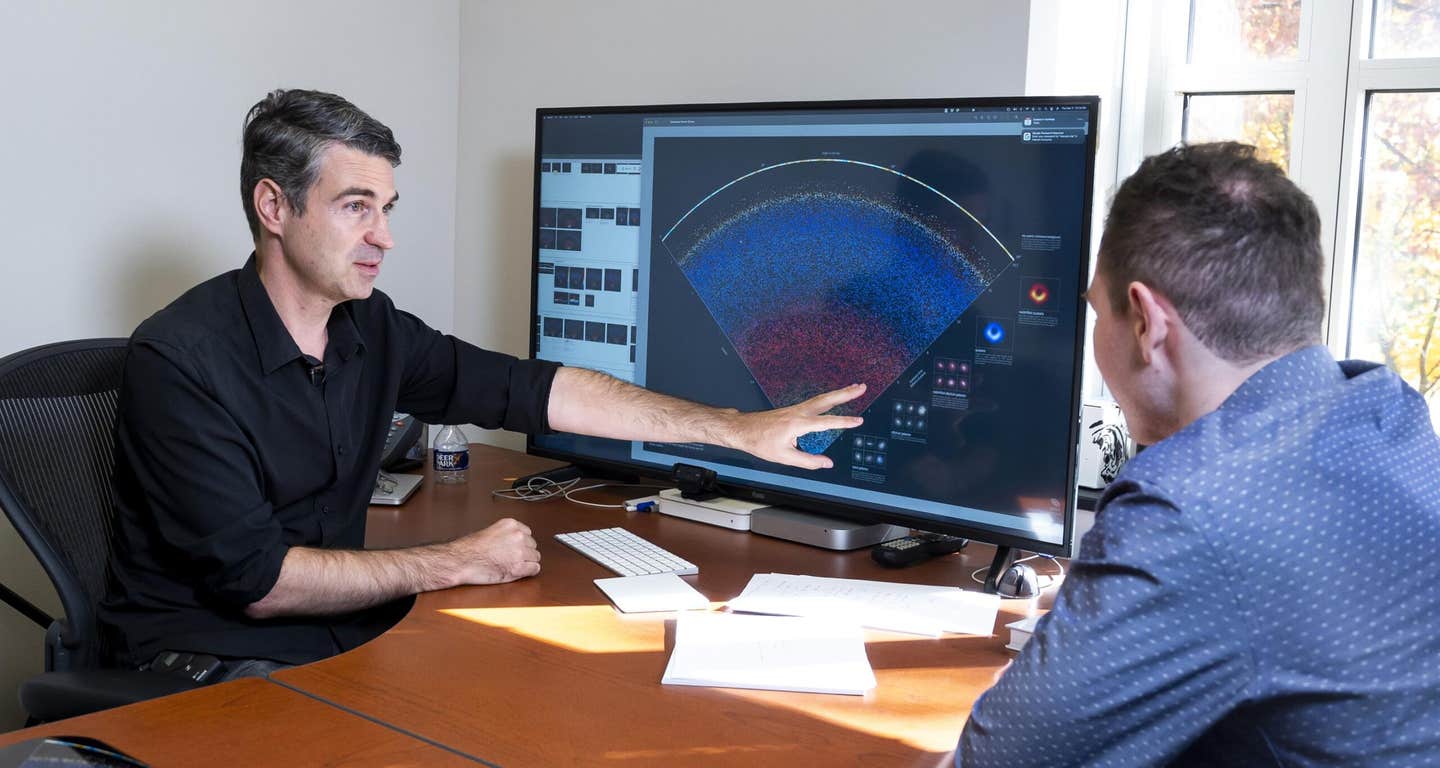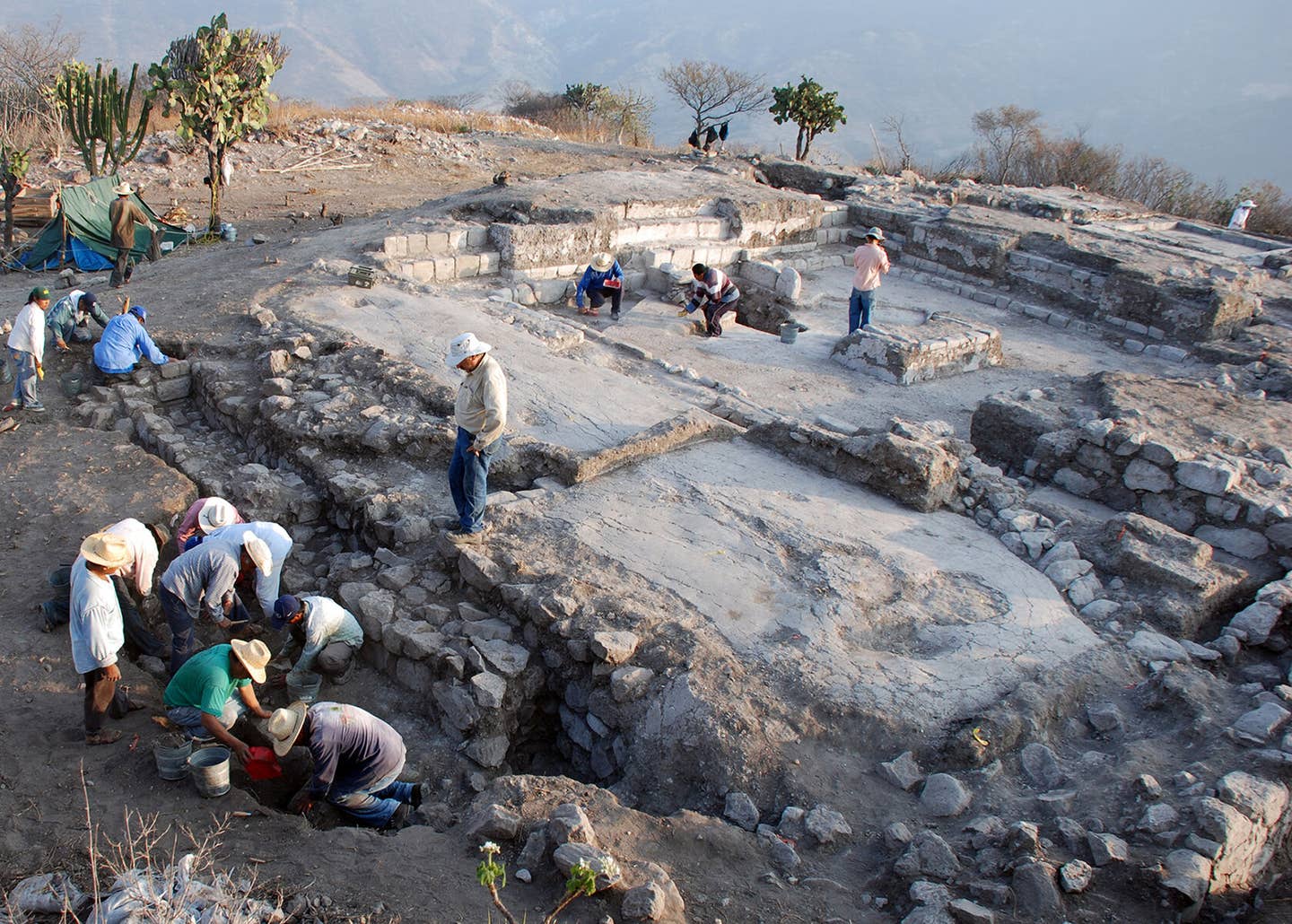Amazing interactive map lets you scroll through the universe
A new map of the universe displays for the first time the span of the entire known cosmos with pinpoint accuracy and sweeping beauty.

[Dec. 12, 2022: Jill Rosen, Johns Hopkins University]
Brice Ménard (left) and Nikita Shtarkman examine the map of the observable universe. (CREDIT: Will Kirk / Johns Hopkins University)
A new map of the universe displays for the first time the span of the entire known cosmos with pinpoint accuracy and sweeping beauty.
Created by Johns Hopkins University astronomers with data mined over two decades by the Sloan Digital Sky Survey, the map allows the public to experience data previously only accessible to scientists.
The interactive map, which depicts the actual position and real colors of 200,000 galaxies, is available online, where it can also be downloaded for free.
"Growing up I was very inspired by astronomy pictures, stars, nebulae and galaxies, and now it's our time to create a new type of picture to inspire people," says map creator Brice Ménard, a professor at Johns Hopkins.
Related Stories
"Astrophysicists around the world have been analyzing this data for years, leading to thousands of scientific papers and discoveries. But nobody took the time to create a map that is beautiful, scientifically accurate, and accessible to people who are not scientists. Our goal here is to show everybody what the universe really looks like", Ménard continued.
The Sloan Digital Sky Survey is a pioneering effort to capture the night sky through a telescope based in New Mexico. Night after night for years, the telescope aimed at slightly different locations to capture this unusually broad perspective.
The map, which Ménard assembled with the help of former Johns Hopkins computer science student Nikita Shtarkman, visualizes a slice of the universe, or about 200,000 galaxies—each dot on the map is a galaxy and each galaxy contains billions of stars and planets. The Milky Way is simply one of these dots, the one at the very bottom of the map.
The expansion of the universe contributes to make this map even more colorful. The farther an object, the redder it appears. The top of the map reveals the first flash of radiation emitted soon after the Big Bang, 13.7 billion years ago.
"In this map, we are just a speck at the very bottom, just one pixel. And when I say we, I mean our galaxy, the Milky Way which has billions of stars and planets," Ménard says. "We are used to seeing astronomical pictures showing one galaxy here, one galaxy there or perhaps a group of galaxies. But what this map shows is a very, very different scale."
In this map, we are just a speck at the very bottom, just one pixel. And when I say we, I mean our galaxy, the Milky Way which has billions of stars and planets. (CREDIT: B. Menard & N. Shtarkman)
Ménard hopes people will experience both the map's undeniable beauty and its awe-inspiring sweep of scale.
"From this speck at the bottom," he says, "we are able to map out galaxies across the entire universe, and that that says something about the power of science."
If you want a crash course on the history of our universe, then check out “The map of the observable Universe” from Johns Hopkins University!
Approximate milestones from the Big Bang:
The Big Bang: 10-43 seconds
The universe begins with a cataclysm that generates space and time, as well as all the matter and energy the universe will ever hold. For an incomprehensibly small fraction of a second, the universe is an infinitely dense, hot fireball. The prevailing theory describes a peculiar form of energy that can suddenly push out the fabric of space. At 10-35 to 10-33 seconds a runaway process called "Inflation" causes a vast expansion of space filled with this energy. The inflationary period is stopped only when this energy is transformed into matter and energy as we know it.
The Universe Takes Shape: 10-6 seconds
After inflation, one millionth of a second after the Big Bang, the universe continues to expand but not nearly so quickly. As it expands, it becomes less dense and cools. The most basic forces in nature become distinct: first gravity, then the strong force, which holds nuclei of atoms together, followed by the weak and electromagnetic forces. By the first second, the universe is made up of fundamental particles and energy: quarks, electrons, photons, neutrinos and less familiar types. These particles smash together to form protons and neutrons.
Formation of Basic Elements: 3 seconds
Protons and neutrons come together to form the nuclei of simple elements: hydrogen, helium and lithium. It will take another 300,000 years for electrons to be captured into orbits around these nuclei to form stable atoms.
The Radiation Era: 10,000 years
The first major era in the history of the universe is one in which most of the energy is in the form of radiation -- different wavelengths of light, X rays, radio waves and ultraviolet rays. This energy is the remnant of the primordial fireball, and as the universe expands, the waves of radiation are stretched and diluted until today, they make up the faint glow of microwaves which bathe the entire universe.
Beginning the Era of Matter Domination: 300,000 years
At this moment, the energy in matter and the energy in radiation are equal. But as the relentless expansion continues, the waves of light are stretched to lower and lower energy, while the matter travels onward largely unaffected. At about this time, neutral atoms are formed as electrons link up with hydrogen and helium nuclei. The microwave background radiation hails from this moment, and thus gives us a direct picture of how matter was distributed at this early time.
Birth of Stars and Galaxies: 300 million years
Gravity amplifies slight irregularities in the density of the primordial gas. Even as the universe continues to expand rapidly, pockets of gas become more and more dense. Stars ignite within these pockets, and groups of stars become the earliest galaxies. This point is still perhaps 12 to 15 billion years before the present.
Birth of the Sun: 5 Billion Years Before the Present (BP)
The sun forms within a cloud of gas in a spiral arm of the Milky Way Galaxy. A vast disk of gas and debris that swirls around this new star gives birth to planets, moons, and asteroids . Earth is the third planet out.
Earliest Life: 3.8 Billion Years BP
The Earth has cooled and an atmosphere develops. Microscopic living cells, neither plants nor animals, begin to evolve and flourish in earth's many volcanic environments.
Primitive Animals Appear: 700 Million Years BP
These are mostly flatworms, jelly fish and algae. By 570 million years before the present, large numbers of creatures with hard shells suddenly appear.
The First Mammals Appear: 200 Million Years BP
The first mammals evolved from a class of reptiles that evolved mammalian traits, such as a segmented jaw and a series of bones that make up the inner ear.
Dinosaurs Become Extinct: 65 Million Years BP
An asteroid or comet slams into the northern part of the Yucatan Peninsula in Mexico. This world-wide cataclysm brings to an end the long age of the dinosaurs, and allows mammals to diversify and expand their ranges.
Homo Sapiens Evolve: 600,000 Years BP
Our earliest ancestors evolve in Africa from a line of creatures that descended from apes.
For more science and technology news stories check out our New Innovations section at The Brighter Side of News.
Note: Materials provided above by Johns Hopkins University. Content may be edited for style and length.
Like these kind of feel good stories? Get the Brighter Side of News' newsletter.
Joseph Shavit
Head Science News Writer | Communicating Innovation & Discovery
Based in Los Angeles, Joseph Shavit is an accomplished science journalist, head science news writer and co-founder at The Brighter Side of News, where he translates cutting-edge discoveries into compelling stories for a broad audience. With a strong background spanning science, business, product management, media leadership, and entrepreneurship, Joseph brings a unique perspective to science communication. His expertise allows him to uncover the intersection of technological advancements and market potential, shedding light on how groundbreaking research evolves into transformative products and industries.



